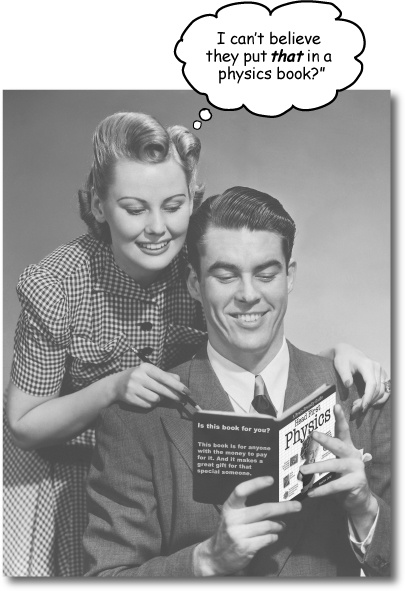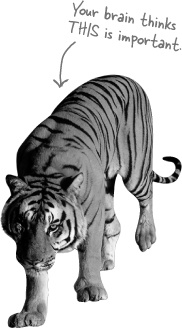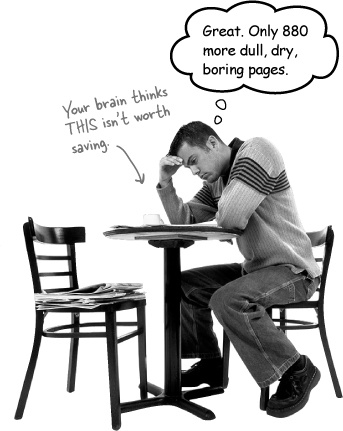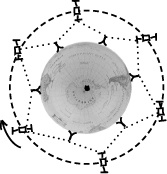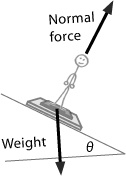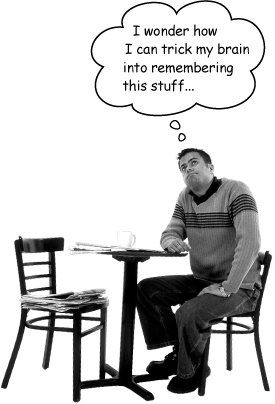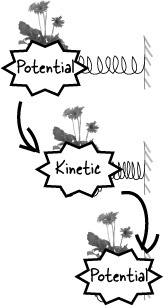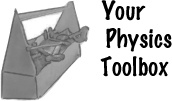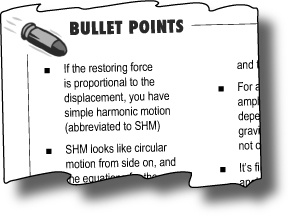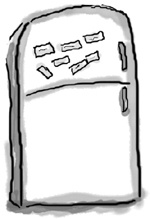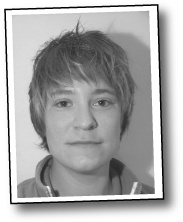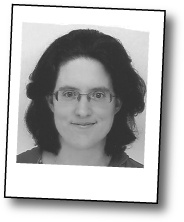How to Use this Book: Intro
Who is this book for?
If you can answer “yes” to all of these:
Do you have access to a pen and a scientific calculator?
Do you want to learn and understand physics by doing, rather than by reading, whether you need to pass an exam at the end or not?
Do you prefer chatting with friends about interesting things to dry, dull, academic lectures?
this book is for you.
Who should probably back away from this book?
If you can answer “yes” to any of these:
Are you someone who’s never studied basic algebra?
(You don’t need to be advanced, but you should be able to add, subtract, multiply and divide. We’ll cover everything else you need to know about math and physics.)
Are you a physics ninja looking for a reference book?
Are you afraid to try something different? Would you rather have a root canal than mix stripes with plaid? Do you believe that a physics book can’t be serious if it involves implementing a training schedule for thoroughbred hamster racing?
this book is not for you.
[Note from marketing: this book is for anyone with the cash to buy it.]
We know what you’re thinking
“How can this be a serious physics book?”
“What’s with all the graphics?”
“Can I actually learn it this way?”
We know what your brain is thinking
Your brain craves novelty. It’s always searching, scanning, waiting for something unusual. It was built that way, and it helps you stay alive.
So what does your brain do with all the routine, ordinary, normal things you encounter? Everything it can to stop them from interfering with the brain’s real job—recording things that matter. It doesn’t bother saving the boring things; they never make it past the “this is obviously not important” filter.
How does your brain know what’s important? Suppose you’re out for a day hike and a tiger jumps in front of you, what happens inside your head and body?
Neurons fire. Emotions crank up. Chemicals surge.
And that’s how your brain knows...
This must be important! Don’t forget it!
But imagine you’re at home, or in a library. It’s a safe, warm, tiger-free zone. You’re studying. Getting ready for an exam. Or trying to learn some tough technical topic your boss thinks will take a week, ten days at the most.
Just one problem. Your brain’s trying to do you a big favor. It’s trying to make sure that this obviously non-important content doesn’t clutter up scarce resources. Resources that are better spent storing the really big things. Like tigers. Like the danger of fire. Like how you should never have posted those photos on your Facebook page.
And there’s no simple way to tell your brain, “Hey brain, thank you very much, but no matter how dull this book is, and how little I’m registering on the emotional Richter scale right now, I really do want you to keep this stuff around.”
Metacognition: thinking about thinking
If you really want to learn, and you want to learn more quickly and more deeply, pay attention to how you pay attention. Think about how you think. Learn how you learn.
Most of us did not take courses on metacognition or learning theory when we were growing up. We were expected to learn, but rarely taught to learn.
But we assume that if you’re holding this book, you really want to learn how to do physics. And you probably don’t want to spend a lot of time. If you want to use what you read in this book, you need to remember what you read. And for that, you’ve got to understand it. To get the most from this book, or any book or learning experience, take responsibility for your brain. Your brain on this content.
The trick is to get your brain to see the new material you’re learning as Really Important. Crucial to your well-being. As important as a tiger. Otherwise, you’re in for a constant battle, with your brain doing its best to keep the new content from sticking.
So just how DO you get your brain to treat physics like it was a hungry tiger?
There’s the slow, tedious way, or the faster, more effective way. The slow way is about sheer repetition. You obviously know that you are able to learn and remember even the dullest of topics if you keep pounding the same thing into your brain. With enough repetition, your brain says, “This doesn’t feel important to him, but he keeps looking at the same thing over and over and over, so I suppose it must be.”
The faster way is to do anything that increases brain activity, especially different types of brain activity. The things on the previous page are a big part of the solution, and they’re all things that have been proven to help your brain work in your favor. For example, studies show that putting words within the pictures they describe (as opposed to somewhere else in the page, like a caption or in the body text) causes your brain to try to makes sense of how the words and picture relate, and this causes more neurons to fire. More neurons firing = more chances for your brain to get that this is something worth paying attention to, and possibly recording.
A conversational style helps because people tend to pay more attention when they perceive that they’re in a conversation, since they’re expected to follow along and hold up their end. The amazing thing is, your brain doesn’t necessarily care that the “conversation” is between you and a book! On the other hand, if the writing style is formal and dry, your brain perceives it the same way you experience being lectured to while sitting in a roomful of passive attendees. No need to stay awake.
But pictures and conversational style are just the beginning...
Here’s what WE did:
We used pictures, because your brain is tuned for visuals, not text. As far as your brain’s concerned, a picture really is worth a thousand words. And when text and pictures work together, we embedded the text in the pictures because your brain works more effectively when the text is within the thing the text refers to, as opposed to in a caption or buried in the text somewhere.
We used redundancy, saying the same thing in different ways and with different media types, and multiple senses, to increase the chance that the content gets coded into more than one area of your brain.
We used concepts and pictures in unexpected ways because your brain is tuned for novelty, and we used pictures and ideas with at least some emotional content, because your brain is tuned to pay attention to the biochemistry of emotions. That which causes you to feel something is more likely to be remembered, even if that feeling is nothing more than a little humor, surprise, or interest.
We used a personalized, conversational style, because your brain is tuned to pay more attention when it believes you’re in a conversation than if it thinks you’re passively listening to a presentation. Your brain does this even when you’re reading.
We included more than 80 activities, because your brain is tuned to learn and remember more when you do things than when you read about things. And we made the exercises challenging-yet-do-able, because that’s what most people prefer.
We used multiple learning styles, because you might prefer step-by-step procedures, while someone else wants to understand the big picture first, and someone else just wants to see an example. But regardless of your own learning preference, everyone benefits from seeing the same content represented in multiple ways.
We include content for both sides of your brain, because the more of your brain you engage, the more likely you are to learn and remember, and the longer you can stay focused. Since working one side of the brain often means giving the other side a chance to rest, you can be more productive at learning for a longer period of time.
And we included stories and exercises that present more than one point of view, because your brain is tuned to learn more deeply when it’s forced to make evaluations and judgments.
We included challenges, with exercises, and by asking questions that don’t always have a straight answer, because your brain is tuned to learn and remember when it has to work at something. Think about it—you can’t get your body in shape just by watching people at the gym. But we did our best to make sure that when you’re working hard, it’s on the right things. That you’re not spending one extra dendrite processing a hard-to-understand example, or parsing difficult, jargon-laden, or overly terse text.
We used people. In stories, examples, pictures, etc., because, well, because you’re a person. And your brain pays more attention to people than it does to things.
Here’s what YOU can do to bend your brain into submission
So, we did our part. The rest is up to you. These tips are a starting point; listen to your brain and figure out what works for you and what doesn’t. Try new things.
Slow down. The more you understand, the less you have to memorize.
Don’t just read. Stop and think. When the book asks you a question, don’t just skip to the answer. Imagine that someone really is asking the question. The more deeply you force your brain to think, the better chance you have of learning and remembering.
Do the exercises. Write your own notes.
We put them in, but if we did them for you, that would be like having someone else do your workouts for you. And don’t just look at the exercises. Use a pencil. There’s plenty of evidence that physical activity while learning can increase the learning.
Read the There are no Dumb Questions
That means all of them. They’re not optional sidebars—they’re part of the core content! Don’t skip them.
Make this the last thing you read before bed. Or at least the last challenging thing.
Part of the learning (especially the transfer to long-term memory) happens after you put the book down. Your brain needs time on its own, to do more processing. If you put in something new during that processing time, some of what you just learned will be lost.
Drink water. Lots of it.
Your brain works best in a nice bath of fluid. Dehydration (which can happen before you ever feel thirsty) decreases cognitive function.
Talk about it. Out loud.
Speaking activates a different part of the brain. If you’re trying to understand something, or increase your chance of remembering it later, say it out loud. Better still, try to explain it out loud to someone else. You’ll learn more quickly, and you might uncover ideas you hadn’t known were there when you were reading about it.
Listen to your brain.
Pay attention to whether your brain is getting overloaded. If you find yourself starting to skim the surface or forget what you just read, it’s time for a break. Once you go past a certain point, you won’t learn faster by trying to shove more in, and you might even hurt the process.
Feel something.
Your brain needs to know that this matters. Get involved with the stories. Make up your own captions for the photos. Groaning over a bad joke is still better than feeling nothing at all.
Do lots of physics!
The main way to learn how to do physics is by... doing physics. And that’s what you’re going to do throughout this book. We’re going to give you a lot of practice: every chapter has exercises that pose problems for you to solve. Don’t just skip over them—a lot of the learning happens when you solve the exercises. We included a solution to each exercise—don’t be afraid to peek at the solution if you get stuck! Look at the first couple of lines, then turn back and take it from there yourself! But try to solve the problem before you look at the solution. And definitely make sure you understand the solution before you move on to the next part of the book.
Read Me
This is a learning experience, not a reference book. We deliberately stripped out everything that might get in the way of learning whatever it is we’re working on at that point in the book. And the first time through, you need to begin at the beginning, because the book makes assumptions about what you’ve already seen and learned.
We begin with experiments, measurements, graphs and equations, then move on to forces and energy conservation, and then more advanced topics such as gravitation and simple harmonic motion.
It’s important to start with a firm foundation. We start out with the building blocks and tools of physics – experiments, measurements, graphs, equations – and most importantly, how to approach problems by thinking like a physicist. But this is no dry, theoretical introduction. Right from the word go, you’ll be picking up these important skills by solving problems yourself. As the book goes on, your brain is freed up to learn new concepts such as Newton’s Laws and energy conservation because you’ve already absorbed and practiced the fundamentals. By the time you reach the end of the book, you’ll even be sending people into space. We teach you what you need to know at the point where it becomes important, as that’s when it has the most value. Yes - even the math!
We cover the same general set of topics that are in the mechanics sections of the AP Physics B and A Level curriculums
While we focus on the overall learning experience rather than exam preparation, we provide good coverage of the mechanics sections of the AP Physics B and A Level curriculums, as well as the practical side of experiments and data analysis in physics. This means that as you work your way through the topics, you gain a deeper understanding that will help you get a good grade in whatever exam you’re taking. You’ll also learn how to break down complicated problems into simpler ones that you already know how to do. This is a far more effective way of learning physics than rote memorization, as you’ll feel confident about tackling any problem even when you haven’t seen one exactly like it before.
We help you out with online resources.
Our readers tell us that sometimes you need a bit of extra help, so we provide online resources, right at your fingertips. We give you an online forum where you can go to seek help, and other resources too. The starting point is
http://www.headfirstlabs.com/books/hfphy/
The activities are NOT optional.
The exercises and activities are not add-ons; they’re part of the core content of the book. Some of them are to help with memory, some are for understanding, and some will help you apply what you’ve learned. Don’t skip the exercises. The crossword puzzles are the only thing you don’t have to do, but they’re good for giving your brain a chance to think about the words and terms you’ve been learning in a different context.
The redundancy is intentional and important.
One distinct difference in a Head First book is that we want you to really get it. And we want you to finish the book remembering what you’ve learned. Most reference books don’t have retention and recall as a goal, but this book is about learning, so you’ll see some of the same concepts come up more than once.
The Brain Power exercises don’t have answers.
For some of them, there is no right answer, and for others, part of the learning experience of the Brain Power activities is for you to decide if and when your answers are right. In some of the Brain Power exercises, you will find hints to point you in the right direction.
The technical review team
Technical Reviewers:
John Allister has degrees from both Oxford and Cambridge universities, including a Master’s in Experimental and Theoretical Physics. He taught physics for 5 years and is currently training for ordination in the Church of England.
Scott Donaldson is an editor, do-it-yourselfer, and all around lover of science and mathematics, with special focus on mechanics and biology.
Georgia Gale Grant is a freelance science writer, communicator and broadcaster. She read Chemistry at Oxford University before an MSc in Science Communication at Imperial College London.
Diane Jaquith earned her Master’s degree in Physics at Wesleyan University. She taught physics, chemistry, and physical science at Durham High School, Durham, CT. She later taught chemistry at Notre Dame College and Pinkerton Academy in Derry, NH.
Catriona Lang studied singing at Birmingham Conservatoire. She currently earns her living as a singing teacher.
Marion Lang is a Classics graduate from St Andrews University who now works as a Nursery Teacher and also runs NYCoS Mini Music Makers classes. She is a member of Stirling Gaelic Choir.
Bill Mietelski is a Software Engineer and a huge Head First & Kathy Sierra fan. He plans on putting the things he learned in Head First Physics to good use while improving his golf game.
Michael Lew is an AP* Physics and Computer Science teacher at Loyola High School in Los Angeles, CA and has been teaching since 1991. In his spare time, he enjoys spending time with his wife, Britt, and his three children, Mike, Jade, and Dane.
Alice Pitt-Pitts enjoyed being a guinea pig reviewer for Head First Physics. She also likes reading, cycling and ice cream and now knows that all of these involve energy conservation!
Get Head First Physics now with the O’Reilly learning platform.
O’Reilly members experience books, live events, courses curated by job role, and more from O’Reilly and nearly 200 top publishers.
